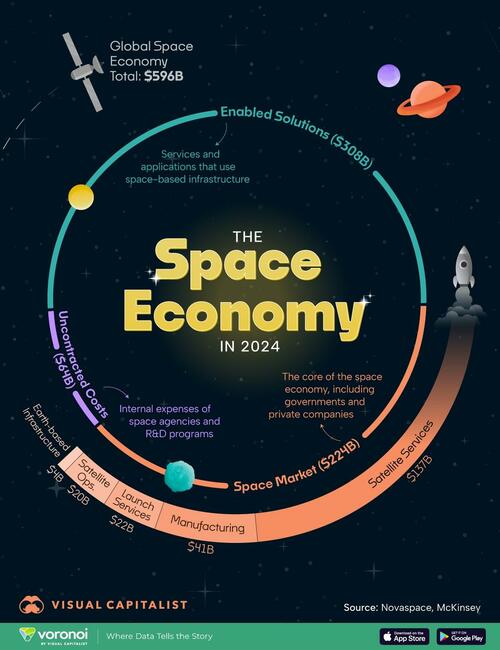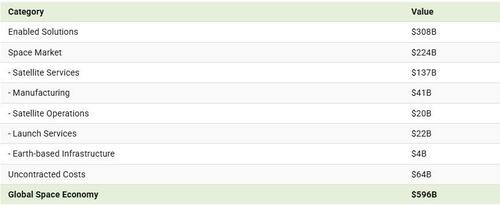
The global space economy reached $596 billion in 2024 and is projected to grow to $944 billion by 2033.
This graphic, via Visual Capitalist's Bruno Venditti, illustrates the size of the space economy as of December 2024, based on data compiled by Novaspace.
The space economy includes government agencies and companies involved in the production and launch of satellites and spacecraft, data generation, Earth-based infrastructure, R&D programs, and more.
Over 10,000 Satellites Orbit the Earth
Space-based applications that are enabled by space, such as weather forecasting, remote sensing, satellite navigation systems, and satellite television, make up the largest portion of the market, representing $308 billion.
Satellite services are another major component of the space economy, generating $137 billion per year. Currently, over 10,000 satellites orbit the Earth, with SpaceX, led by Elon Musk, controlling half of the market.
Upward Trajectory
2024 set spaceflight records for the fourth consecutive year, with 259 launches worldwide—an average of one launch attempt every 34 hours, according to a recent analysis of the global space economy.
The study, published by The Space Report, also predicts that the pace of launches will continue to rise this year.
The U.S. dominated the launch cycle in 2024, outpacing China by more than 2-to-1, according to the report. Meanwhile, Russia significantly increased the number of satellites it deployed into Earth orbit, rising from 21 in 2023 to 98 in 2024.
If you enjoyed this post, check out Visualized: Every Moon in the Solar System on Voronoi, the new app from Visual Capitalist.
The global space economy reached $596 billion in 2024 and is projected to grow to $944 billion by 2033.
This graphic, via Visual Capitalist’s Bruno Venditti, illustrates the size of the space economy as of December 2024, based on data compiled by Novaspace.
The space economy includes government agencies and companies involved in the production and launch of satellites and spacecraft, data generation, Earth-based infrastructure, R&D programs, and more.
Over 10,000 Satellites Orbit the Earth
Space-based applications that are enabled by space, such as weather forecasting, remote sensing, satellite navigation systems, and satellite television, make up the largest portion of the market, representing $308 billion.
Satellite services are another major component of the space economy, generating $137 billion per year. Currently, over 10,000 satellites orbit the Earth, with SpaceX, led by Elon Musk, controlling half of the market.
Upward Trajectory
2024 set spaceflight records for the fourth consecutive year, with 259 launches worldwide—an average of one launch attempt every 34 hours, according to a recent analysis of the global space economy.
The study, published by The Space Report, also predicts that the pace of launches will continue to rise this year.
The U.S. dominated the launch cycle in 2024, outpacing China by more than 2-to-1, according to the report. Meanwhile, Russia significantly increased the number of satellites it deployed into Earth orbit, rising from 21 in 2023 to 98 in 2024.
If you enjoyed this post, check out Visualized: Every Moon in the Solar System on Voronoi, the new app from Visual Capitalist.
Loading…






